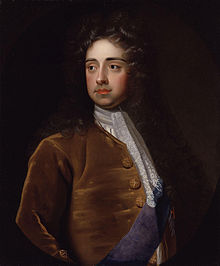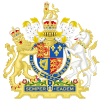| Lord High Treasurer of the United Kingdom | |
|---|---|
 Charles Talbot, 1st Duke of Shrewsbury, last holder of the office as Lord High Treasurer of Great Britain in 1714 Charles Talbot, 1st Duke of Shrewsbury, last holder of the office as Lord High Treasurer of Great Britain in 1714 | |
| His Majesty's Treasury | |
| Type | Great Officer of State |
| Appointer | The Monarch |
| Term length | At His Majesty's Pleasure |
| Precursor |
|
| Formation |
|
| First holder | Nigel of Ely as Lord High Treasurer of England |
| Final holder | Charles Talbot, 1st Duke of Shrewsbury as Lord High Treasurer of Great Britain |
| Superseded by | Prime Minister of the United Kingdom and First Lord of the Treasury Chancellor and Under Treasurer of His Majesty's Exchequer and Second Lord of the Treasury Lords Commissioners of His Majesty's Treasury |
The Lord High Treasurer was an English government position and has been a British government position since the Acts of Union of 1707. A holder of the post would be the third-highest-ranked Great Officer of State in England, below the Lord High Steward and the Lord High Chancellor of Great Britain.
The Lord High Treasurer functions as the head of His Majesty's Treasury. The office has, since the resignation of Charles Talbot, 1st Duke of Shrewsbury in 1714, been vacant.
Although the United Kingdom of Great Britain and Ireland was created in 1801, it was not until the Consolidated Fund Act 1816 that the separate offices of Lord High Treasurer of Great Britain and Lord High Treasurer of Ireland were united into one office as the "Lord High Treasurer of the United Kingdom of Great Britain and Ireland" on 5 January 1817.
Section 2 of the Consolidated Fund Act 1816 also provides that "whenever there shall not be , it shall ... be lawful for His Majesty, by letters patent under the Great Seal of Great Britain, to appoint Commissioners for executing the Offices of Treasurer of the Exchequer of Great Britain and Lord High Treasurer of Ireland". These are the Lords Commissioners of the Treasury. In modern times, by convention, the Lords Commissioners of the Treasury include the Prime Minister of the United Kingdom, usually serving as the First Lord of the Treasury, and the Chancellor of the Exchequer, serving as the Second Lord of the Treasury. Other members of the government, usually whips in the House of Commons, are appointed to serve as the Junior Lords Commissioners of the Treasury.
Origins
The English Treasury seems to have come into existence around 1126, during the reign of Henry I, as the financial responsibilities were separated from the rest of the job that evolved into Lord Great Chamberlain. The Treasury was originally a section of the Royal Household with custody of the King's money. In 1216, a Treasurer was appointed to take control of the Treasury in Winchester. The Treasurer was also an officer of the Exchequer, and supervised the royal accounts. It was in the 16th century, the office's title of King's Treasurer developed into Lord High Treasurer. By Tudor times, the Lord High Treasurer had achieved a place among the Great Officers of State, behind the Lord Chancellor and above the Master of the Horse. Under the Treason Act 1351 it is treason to kill him.

The office of Lord High Treasurer is distinct from that of Treasurer of the Exchequer. The Lord High Treasurer was appointed by the delivery of a white staff to the appointee, and the Treasurer of the Exchequer was appointed at His Majesty's pleasure by letters patent under the Great Seal of the Realm. However, when the Treasury was held by an individual, he was appointed to both offices. It is the office of Treasurer of the Exchequer that is put into commission, not the office of Lord High Treasurer. When the office of Treasurer of the Exchequer is put into commission, the office of Lord High Treasurer is left vacant.
During the sixteenth century, the Lord High Treasurer was often considered the most important official of the government, and became a de facto Prime Minister. Exemplifying the power of the Lord High Treasurer is William Cecil, 1st Baron Burghley, who served in the post from 1572 to 1598. During his tenure, he dominated the administration under Elizabeth I.
List
Main article: List of lord high treasurers of England and Great BritainSee also
- List of lord high treasurers of England and Great Britain
- List of lords commissioners of the Treasury
References
Citations
- ^ "Consolidated Fund Act 1816". legislation.gov.uk. UK Government. p. Section 2. Retrieved 18 November 2016.
- ^ Anson, Sir William Reynell (1892). The Law and Custom of the Constitution, Part 2. Oxford, Oxfordshire: Clarendon Press. pp. 163–164. Retrieved 19 October 2021.
- ^ Sainty, John Christopher (1972). Office-Holders in Modern Britain: Volume 1, Treasury Officials 1660–1870. London: University of London. pp. 16–25. ISBN 0485171414. Retrieved 19 October 2021.
- Loades, D., The Cecils: Privilege and Power behind the throne, The National Archives, 2007.
Sources
 Chisholm, Hugh, ed. (1911). "Lord High Treasurer". Encyclopædia Britannica (11th ed.). Cambridge University Press.
Chisholm, Hugh, ed. (1911). "Lord High Treasurer". Encyclopædia Britannica (11th ed.). Cambridge University Press.
| Lord High Treasurers of pre-Plantagenet England (1126–1216) | |||||||
|---|---|---|---|---|---|---|---|
| House of Normandy (1066–1135) |
| ||||||
| House of Blois (1135–1154) |
| ||||||
| House of Anjou (1154–1216) |
| ||||||
| English Lord High Treasurers under the House of Plantagenet (1216–1399) | ||
|---|---|---|
| Henry III (1216–1272) |
|  |
| Edward I (1272–1307) |
| |
| Edward II (1307–1327) |
| |
| Edward III (1327–1377) |
| |
| Richard II (1377–1399) |
| |
| English Lord High Treasurers under the House of Lancaster (1399–1461; 1470–1471) | ||
|---|---|---|
| Henry IV (1399–1413) |
|  |
| Henry V (1413–1422) |
| |
| Henry VI (1422–1461) (1470–1471) |
| |
| English Lord High Treasurers under the House of York (1461–1470; 1471–1485) | ||
|---|---|---|
| Edward IV (1461–1470) (1471–April 1483) |
|  |
| Edward V (April–June 1483) |
| |
| Richard III (June 1483–1485) |
| |
| English Lord High Treasurers under the House of Tudor (1485–1603) | ||
|---|---|---|
| Henry VII (1485–1509) |
|  |
| Henry VIII (1509–1547) |
| |
| Edward VI (1547–1553) |
| |
| Lady Jane Grey (July 1553) |
| |
| Mary I (July 1553–1558) |
| |
| Elizabeth I (1558–1603) |
| |
| British Lord High Treasurers under the House of Stuart (1603–1649; 1660–1714) | ||
|---|---|---|
| James I (1603–1625) |
|  |
| Charles I (1625–1649) |
| |
| Charles II (1660–1685) |
| |
| James II (1685–1688) |
| |
| William & Mary (1689–1694) |
| |
| William III (1694–1702) |
| |
| Anne (1702–1714) |
| |
| Italics indicate service as First Lord of the Treasury when HM Treasury was ruled by Commission | ||
| Direction and control Naval affairs |
|
|---|---|
| Under the offices of Direction and control | |
| Direction of Military Units | |
| Military units | |
| Admiralty Departments Under Lord High Admiral/Board of Admiralty |
|
| Civil Departments Under Council of the Marine & Navy Board |
|
| Autonomous Civil Departments Arms and Ordnance | |
| Direction of Naval Finance | |
| Departments under the Treasurer | |
| Direction of Naval Administration |
|
| Branches and offices under the Secretary to the Admiralty | |
| Legal Services | |
| Legal under Judicial Department |
|

